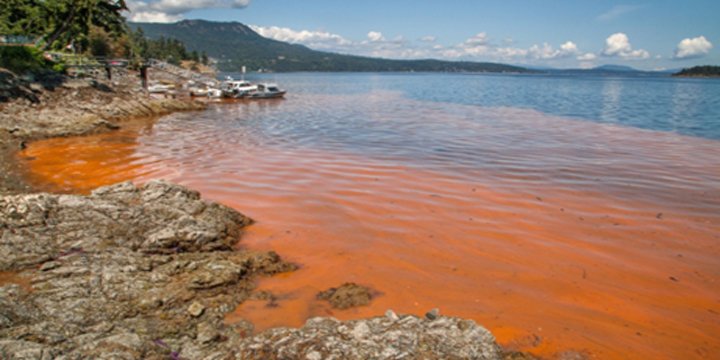RED ALGAL BLOOMS IN INDIAN WATER BODIES
What Are Red Algal Blooms?
- Red algal blooms are visible discolorations (red or pink) of water surfaces caused by microscopic photosynthetic organisms.
- In Indian water bodies, these blooms are often not true algae but caused by Euglenophytes, specifically the genus Euglena and its relatives.
- These microorganisms thrive in stagnant, nutrient-rich, oxygen-depleted waters, especially in urban and peri-urban lakes, ponds, ditches, and temple tanks.
ABOUT EUGLENOPHYTES
| Feature | Details |
| Scientific Group | Euglenophyta |
| Organism Type | Unicellular, flagellated protists |
| Common Genera in India | Euglena, Phacus, Trachelomonas species |
| Habitats | Stagnant freshwater, ditches, lakes with poor circulation |
| Feeding Mechanism | Mixotrophic – capable of photosynthesis and absorbing organic matter |
| Pigment Responsible for Red Colour | Astaxanthin, a fat-soluble xanthophyll pigment |
WHY DOES THE WATER TURN RED?
- The red or pink coloration of the water during blooms is caused by astaxanthin, produced in high concentrations by certain Euglenophyte species.
- This occurs mostly in eutrophic conditions – environments rich in nitrates and phosphates, often due to:
- Sewage discharge
- Agricultural runoff
- Industrial effluents
NEGATIVE IMPACTS
- Oxygen Depletion
- Photosynthesis occurs during the day, but at night, Euglenoids consume oxygen, leading to diurnal oxygen fluctuations.
- This causes hypoxia (low oxygen levels), affecting fish and other aquatic life.

- Dense Surface Scums
- Blooms form thick mats that block sunlight, affecting submerged aquatic vegetation.
- Disrupts photosynthesis of native plants, impacting lake productivity and ecological balance.
- Fish Mortality
- Euglenoid masses clog fish gills, suffocating them.
- Some species release toxins such as euglenophycin, causing direct mortality or weakening the food chain.
- Aesthetic and Cultural Degradation
- Foul odours, discolouration, and scum layers degrade:
- Religious and cultural value of temple tanks and community ponds
- Tourism and recreational use of lakes
- Foul odours, discolouration, and scum layers degrade:
- Water Treatment Challenges
- Blooms clog filtration systems, impart bad taste and odour.
- Increase the cost and complexity of treating water for domestic and drinking use.
- Threat to Aquaculture
- Blooms reduce water quality and disrupt fish health in aquaculture ponds.
- Associated with toxic alkaloids that harm fish stock and reduce farm income.
- Documented economic losses in India due to such bloom events in the 21st century.
IMPORTANCE OF ECOLOGICAL UNDERSTANDING
Gaps in Scientific Knowledge:
- Limited research on euglenoid ecology, especially in India.
- Need to understand:
- Seasonal abundance
- Toxin production
- Response to pH, temperature, and nutrient levels
Importance of Monitoring:
- Regular microscopic water quality analysis
- Long-term ecological assessments of urban water bodies
- Public awareness on recognizing signs of ecosystem stress (e.g., red-coloured water)
The Indian Urban Context
- Urban water bodies are:
- Heavily polluted due to untreated sewage and solid waste
- Nutrient-rich, making them ideal for Euglenophyte proliferation
- These organisms have become bio-indicators of ecological degradation in Indian cities
Specific Impacts in India:
- Signal of organic pollution and sewage contamination
- Oxygen depletion, affecting fish and aquatic biodiversity
- Surface mats block light and ruin aesthetics
- Filter clogging in decentralized water treatment units
- Community disconnection from water bodies due to foul smell and poor visual quality
RED WATER AS A BIOLOGICAL RED FLAG
- Much like a red traffic light, red water signals “stop and take action”.
- It is a visible symptom of deeper ecological problems, often linked to:
- Urbanisation
- Poor wastewater management
- Eutrophication from unchecked nutrient input
WAY FORWARD: POLICY + ACTION
Immediate Actions Needed:
- Strengthen sewage and waste management
- Implement regular monitoring of algal communities
- Use ecosystem-based restoration (e.g., constructed wetlands, native aquatic plants)
- Promote citizen science and awareness
- Revive ecological research in academic institutions
Policy Measures:
- Mandate microscopic and chemical analysis in urban lake management
- Implement urban lake protection policies with clear accountability
- Integrate waterbody health indicators into urban planning and smart city initiatives
Note: Connect with Vajirao & Reddy Institute to keep yourself updated with latest UPSC Current Affairs in English.
Note: We upload Current Affairs Except Sunday.

